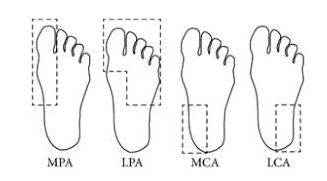How to Become a Data Scientist in 2022
Prediction of Diabetic Foot Ulceration using Machine Learning Techniques
Prediction of Diabetic Foot Ulceration using Machine Learning Techniques
Objectives of Diabetic Foot Ulceration
The Case study – Diabetic Foot Ulceration elaborates about the automating a system, thus by modelling, validating and testing on the real time data to classify whether a diabetic patient is having Foot Ulcer symptoms or not. Further assisting the health departments in controlling using dynamic plantar pressure distribution data. Dynamic plantar pressure measurements are recorded using wireless foot pressure insoles. Several new features are proposed here such as Maximum Gradient, Minimum Gradient and Full Width at Half Maximum (FWHM) along with other previously used features; namely, Peak Plantar Pressure (PPP) and Pressure Time Integral (PTI). Machine learning and data mining techniques are applied to accurately classify between different groups using Support Vector Machine (SVM) classifiers.
This proposed model can be potentially used as a screening tool to allow early detection, and hence prevention of neuropathic foot ulcers in diabetic patients. This case thesis presents the first application of automated machine learning techniques on the spatial and temporal dynamic measurements of plantar pressure towards the prediction of diabetic foot complications.
What is Diabetic Foot Ulcer?
Diabetes Mellitus is a serious global health concern affecting about 8.8% of adults worldwide. Among other complications of the disease, diabetic foot ulceration (DFU) is one of the most serious, possibly leading to amputation. The International Diabetes Federation (IDF) estimated that around 415 million people worldwide, aged between 20-79 in the world had DM in 2015. Diabetes accounted for 14.5% of global all-cause mortality among people in this age group resulting in approximately 5 million deaths in 2015 which is higher than the combined number of deaths from infectious diseases like HIV/AIDS, tuberculosis and malaria.
Egypt has the largest number of adults with diabetes in the Middle East and North Africa (MENA) region. At a prevalence rate of 14.9%, Egypt has 7.8 million adults suffering from diabetes in 2015 which makes it the 8th country in the world having a very large number of adults with diabetes. So, there was a need for a model which can automate the system and helps in diagnosing these diseases and helping doctors in faster treatment of such issues.

Hyperglycemia, the increased level of glucose in the blood associated with diabetes, has many serious complications which lead to an altered plantar pressure distribution, hence in turn can develop a plantar ulceration, serious infections and possibly result in lower limb amputation. Plantar pressure measurements have been widely used for determining risk of ulcers development and specifically the foot regions that are susceptible to high plantar pressures or highly repetitive moderate pressures leading to tissue breakdown.

Methodology - Diabetic Foot Ulceration
Here are the methodological steps to implement the model, which are listed below:
- Data Acquisition
- Feature Selection
- Prediction based on the classification
- Validation and testing process

1. In Data Acquisition process, wireless sensors are connected on the foot of Patients and are sampled at a frequency of 300Hz. Before data acquisition, patients were instructed to walk freely in the clinic to reproduce their daily gait and to adapt to the clinic environment and equipment. For each trial, patients were asked to walk at their preferred speed along a straight 15m long walkway while recording the dynamic measurements.
2. We have divided the foot in the plantar surface with 11 different regions: Big toe, second and third toes, fourth and fifth toes, first metatarsal, second metatarsal, third metatarsal, fourth metatarsal, fifth metatarsal, medial mid-foot, lateral mid-foot and heel as shown in the figure mentioned above:
3. Feature Selection was performed using principal component analysis (PCA) in order to find out the minimum number of features needed for the Machine learning algorithm to predict the output hence simplifying the model.
4. Further Features are evaluated to determine the importance of each of them as a classification feature using an SVM classifier.
5. SVM classifier is a supervised machine learning algorithm that maps the input data space to a space of higher-dimension to achieve more accurate classification when the data sets are not easily separable.
6. Using an SVM classifier we can achieve an approximate accuracy of 93% to 96. % indicating that this system has the potential for wide clinical use.
Conclusion
The model was successfully implemented and thus validated on the testing dataset. Each step was followed step by step from data acquisition to feature selection and ending up with the machine learning algorithm in achieving the accuracy level of true prediction. The Support Vector Machine, supervised based machine learning algorithm was used. The accuracy level achieved was approximately 94% based on the variant samples selected which seems the model as pretty good for predictive analysis
Recently Published
Popular Newsletters
Most Viewed
How to Write and Publish an Academic Research
Various domains for final year project of an
ENGINEERING PROJECT IDEAS FOR FINAL YEAR STUDENTS Engineering
SELECTING THE RIGHT PROJECT FOR FINAL YEAR Selecting
AIR QUALITY MONITORING SYSTEM BASED ON IOT USING
Trending
Contact us for complete code
Address List
- # 28, 1st Main Road,1st Cross, Shakthi Garden, Kalyan Nagara, Bengaluru-72
- +91-968-696-3065
- eng@pincore.in














